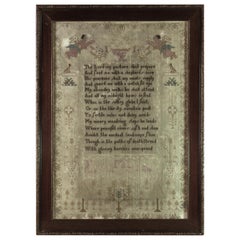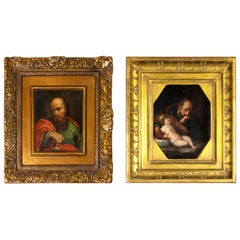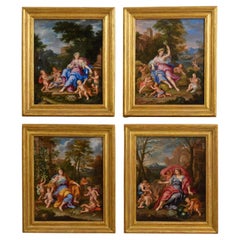Wall Decorations
17th Century Italian Baroque Antique Wall Decorations
Walnut
Late 19th Century Serbian Baroque Antique Wall Decorations
Canvas, Wood, Giltwood
1810s Georgian Antique Wall Decorations
Natural Fiber
18th Century Italian Baroque Antique Wall Decorations
Copper
Late 17th Century French Baroque Antique Wall Decorations
Canvas
Late 18th Century Italian Baroque Antique Wall Decorations
Canvas
Late 18th Century Georgian Antique Wall Decorations
Wood
17th Century German Baroque Antique Wall Decorations
Paint
Late 20th Century Portuguese Baroque Wall Decorations
Delft, Faience, Terracotta
18th Century British Georgian Antique Wall Decorations
Copper
Early 18th Century French Baroque Antique Wall Decorations
Wood, Giltwood
1960s Italian Baroque Vintage Wall Decorations
Wood
19th Century French Baroque Antique Wall Decorations
Enamel
1660s Belgian Baroque Antique Wall Decorations
Wool
Early 19th Century English Georgian Antique Wall Decorations
Paper
Early 18th Century Italian Baroque Antique Wall Decorations
Paint
17th Century Spanish Baroque Antique Wall Decorations
Paint
17th Century Belgian Baroque Antique Wall Decorations
Wood
19th Century Italian Baroque Antique Wall Decorations
Paint
Late 20th Century Portuguese Baroque Wall Decorations
Delft, Faience, Terracotta
1990s Italian Baroque Wall Decorations
Paper
17th Century European Baroque Antique Wall Decorations
Paper
1940s Belgian Baroque Vintage Wall Decorations
Canvas, Wood, Paint
Late 18th Century English Georgian Antique Wall Decorations
Wood
17th Century Italian Baroque Antique Wall Decorations
Paper
Late 18th Century English Georgian Antique Wall Decorations
Wood
Mid-17th Century Belgian Baroque Antique Wall Decorations
Wool, Silk
19th Century Italian Baroque Antique Wall Decorations
Paint
1680s Italian Baroque Antique Wall Decorations
Canvas
18th Century and Earlier Dutch Baroque Antique Wall Decorations
Silk, Wool
17th Century Italian Baroque Antique Wall Decorations
Paint
18th Century European Baroque Antique Wall Decorations
Canvas
19th Century German Baroque Antique Wall Decorations
Canvas
Early 18th Century Italian Baroque Antique Wall Decorations
Canvas
1740s German Georgian Antique Wall Decorations
Paper
1780s Spanish Baroque Antique Wall Decorations
Gold Leaf
19th Century Italian Baroque Antique Wall Decorations
Fruitwood
17th Century Spanish Baroque Antique Wall Decorations
Other
Late 17th Century Italian Baroque Antique Wall Decorations
Canvas
1950s Belgian Baroque Vintage Wall Decorations
Canvas, Wood, Paint
Early 20th Century Italian Baroque Wall Decorations
Maiolica, Porcelain
17th Century Italian Baroque Antique Wall Decorations
Porcelain, Maiolica
20th Century Italian Baroque Wall Decorations
Glass, Wood, Paper
18th Century Dutch Baroque Antique Wall Decorations
Wood
20th Century Dutch Georgian Wall Decorations
Delft
17th Century English Baroque Antique Wall Decorations
Paper
1780s French Georgian Antique Wall Decorations
Paper
17th Century Dutch Baroque Antique Wall Decorations
Paint
18th Century British Baroque Antique Wall Decorations
Canvas
Early 18th Century Italian Baroque Antique Wall Decorations
Paint
1850s French Baroque Antique Wall Decorations
Wood, Oak
1760s English George III Antique Wall Decorations
Pine
19th Century English Baroque Antique Wall Decorations
Maple, Paint
18th Century Italian Baroque Antique Wall Decorations
Gold Leaf
Early 20th Century English George IV Wall Decorations
Glass, Wood, Paint, Paper
1870s German Baroque Antique Wall Decorations
Porcelain
Mid-18th Century English George II Antique Wall Decorations
Wool, Silk
18th Century Spanish Baroque Antique Wall Decorations
Paint
Antique and Vintage Wall Decor and Decorations
An empty wall in your home is a blank canvas, and that’s good news. Whether you’ve chosen to arrange a collage of paintings in a hallway or carefully position a handful of wall-mounted sculptures in your dining room, there are a lot of options for beautifying your space with the antique and vintage wall decor and decorations available on 1stDibs.
If you’re seeking inspiration for your wall decor, we’ve got some ideas (and we can show you how to arrange wall art, too).
“I recommend leaving enough space above the piece of furniture to allow for usable workspace and to protect the art from other items damaging it,” says Susana Simonpietri, of Brooklyn home design studio Chango & Co.
Hanging a single attention-grabbing large-scale print or poster over your bar or bar cart can prove intoxicating, but the maximalist approach of a salon-style hang, a practice rooted in 17th-century France, can help showcase works of various shapes, styles and sizes on a single wall or part of a wall.
If you’re planning on creating an accent wall — or just aiming to bring a variety of colors and textures into a bedroom — there is more than one way to decorate with wallpaper. Otherwise, don’t overlook what textiles can introduce to a space. A vintage tapestry can work wonders and will be easy to move when you’ve found that dream apartment in another borough.
Express your taste and personality with the right ornamental touch for the walls of your home or office — find a range of contemporary art, vintage photography, paintings and other wall decor and decorations on 1stDibs now.




